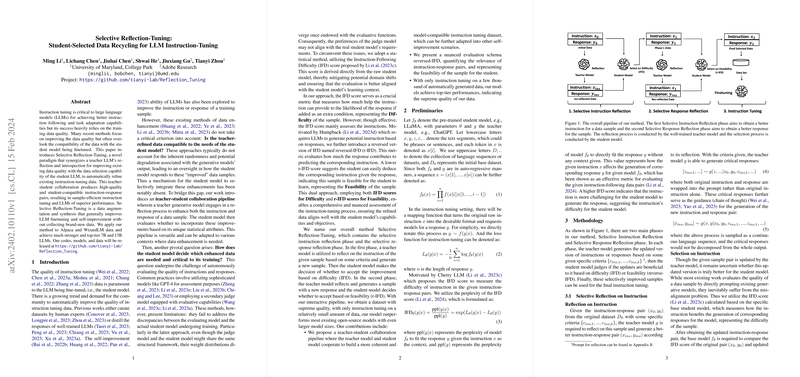Selective Reflection-Tuning: An In-Depth Analysis
The paper presents a novel approach, Selective Reflection-Tuning, aimed at optimizing the instruction tuning process for LLMs. This methodology leverages a collaborative teacher-student model framework to enhance the quality of instruction-response data efficiently, without the need to source new datasets.
Core Concepts
Selective Reflection-Tuning innovatively merges data synthesis with selection processes to improve dataset-quality compatibility for student models. It does so through interlinking reflection capabilities of a teacher model and selection processes of a student model, concentrating on refining existing instruction-tuning data. This synergy results in generating high-quality, student-compatible instruction-response pairs, leading to substantial improvements in LLM performance while ensuring efficient sample usage.
Methodological Framework
The paper delineates a dual-phase process comprising Selective Instruction Reflection and Selective Response Reflection. Initially, a teacher model improves data samples based on instructive criteria, generating new samples. The student model evaluates these using the Instruction-Following Difficulty (IFD) and reversed IFD (r-IFD) scores to decide on their utility, thus ensuring alignment with its statistical characteristics:
- Instruction-Following Difficulty (IFD): Assesses how effectively an instruction adds value to predicting a resultant response, highlighting difficulty.
- Reversed IFD (r-IFD): Gauges the feasibility of deducing instructions from responses, emphasizing alignment with the student model's learning capacity.
Through iterative reflection and evaluation, the pipeline yields highly coherent and effective instruction-response datasets, underscoring enhanced self-improvement capabilities in LLMs.
Numerical Insights
The implementation of this method on existing datasets such as Alpaca and WizardLM demonstrated significant performance enhancement in resulting LLMs, as evidenced by evaluations on industry-standard benchmarks like the AlpacaEval and Huggingface Open LLM Leaderboards. Notably, models trained on these refined datasets reached performance levels comparable to, or surpassing, larger models necessitating less computational data.
Implications and Future Directions
This research exhibits profound implications for both theoretical advancements and practical applications in LLM development, facilitating more precise and resource-efficient model training processes. The use of IFD and r-IFD scores allows for a nuanced approach to model-specific data tailoring, bridging gaps in existing approaches that disregard compatibility between data and the target LLM.
Future research could explore extending this reflection-tuning framework to diverse LLM architectures and heterogeneous datasets. Investigations into automating reflection criteria or further refining selection metrics may yield heightened adaptability and efficiency across varying AI landscapes.
Overall, Selective Reflection-Tuning exemplifies a significant leap forward in LLM instruction tuning, promising streamlined, resource-conscious, yet highly effective model training methodologies that align meticulously with student models’ inherent parameters.
